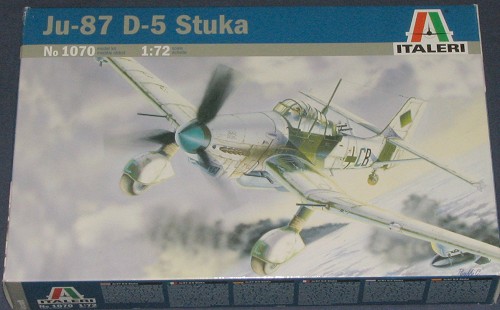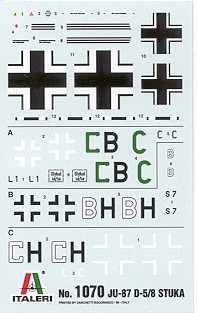
| KIT: | Italeri 1/72 Ju-87D-5 Stuka |
| KIT #: | 1070 |
| PRICE: | $18.00 MSRP |
| DECALS: | Three options |
| REVIEWER: | Scott Van Aken |
| NOTES: | Revell AG mold |

| HISTORY |
The Ju-87 dive bomber is certainly one of the most famous aircraft of WWII. This characteristic 'inverted gullwing' aircraft became most well known in the early years of the war when Germany had virtual control of the skies in the battle field. Later, when up against a more modern and determined enemy, its weakness became more obvious. It was then that the majority of Stukas were removed from Western Europe to fight on the Eastern Front against the Russians, where its robust construction and ease of maintenance became paramount. During the final year of the war, it was used in many night bombing units. In this case the ability to fly low and slow were quite important, and some success was achieved before the lack of fuel and time brought things to a conclusion.
| THE KIT |
 This
kit was another of the 'I wonder whose kit is being reboxed' sort of deals.
However, it really doesn't look like any other 1/72 Stuka that I've seen
before, so I have to conclude that this is yet another new mold kit. (I've
since been told that this was originally issued by Revell AG in the 1990s) Prior
to this, the best Ju-87 kits in this scale were by Fujimi. Availability of
Fujimi kits has been sporadic at best and often were not around at all.
This
kit was another of the 'I wonder whose kit is being reboxed' sort of deals.
However, it really doesn't look like any other 1/72 Stuka that I've seen
before, so I have to conclude that this is yet another new mold kit. (I've
since been told that this was originally issued by Revell AG in the 1990s) Prior
to this, the best Ju-87 kits in this scale were by Fujimi. Availability of
Fujimi kits has been sporadic at best and often were not around at all.
There are two sprues of grey plastic and one of clear. The clear bits are bagged while the rest is loose in the box. Thanks to the close confines of the packaging, no parts separated from the trees or were broken off. Detail level is very good. The engraved panel lines may be a bit too much for some, but for me, they are about right. Surface of many of the plastic parts is a tad 'pebbly', but this should disappear under a coat of paint. My usual quest for molding glitches only found some ejector pin marks on the rear cockpit instrument panel and the bomb racks. I also found a teeny bit of flash on the rear part of the landing gear covers. The cockpit sections are in three parts, allowing the forward canopy to be displayed open.
Interior bits include a pilot's seat
with molded in harness, control stick, instrument panel, rear radio panel,
and gunner's seat. The instrument panel has raised detail, but no dial
detail. I would bet that other variants are plann ed
(or already out there) as the nose section is separate (as on the Fujimi
kits). Only spatted wheels are provided, so you'll have to go to
aftermarket for the 'bare strut' look. One does need to open holes on the
lower wing for the various bits. You have dive brakes on this one as well
as a central bomb and two wing bomb racks. Optional exhaust are provided
with one set being tubular to provide flame dampening properties for night
missions.
ed
(or already out there) as the nose section is separate (as on the Fujimi
kits). Only spatted wheels are provided, so you'll have to go to
aftermarket for the 'bare strut' look. One does need to open holes on the
lower wing for the various bits. You have dive brakes on this one as well
as a central bomb and two wing bomb racks. Optional exhaust are provided
with one set being tubular to provide flame dampening properties for night
missions.
Instructions are well done with color information provided by generic and Testors Model Master references. RLM numbers would be nice as well as I doubt I'll use FS 34227 for the one of the upper camo colors. Especially as it is a rather bright green and one really needs to use RLM 71 Dark Green (a color available in the Model Master line). The instructions do have you installing the lower wing radiators backwards so be aware of that. Markings are for three aircraft. All are basically RLM 70/71/65 with yellow lower outer wing markings. One is the box art aircraft from I./SG 5 in Russia during 1944 that has most of the airframe painted in winter white. Next is from I./SG 3, also in Russia during 1944. The entire upper surface of this is white and it has a yellow fuselage band. The final one is a D-8 from I./NSG 9 in Italy during 1944. It also has a yellow fuselage band, which is not correct for Italy as the ID markings should be white. It has an overall scribble pattern in RLM 76 sprayed over the top surface. Decals are well done and my experience with new Italeri decals has been very positive.
| CONCLUSIONS |
This looks to be a very impressive kit. The level of detail is quite good, yet leaves some room for additional stuff if you are one of those who likes more detail. It compares well with the Fujimi kit and is probably a bit better from the look of the sprues. It is one that you should find to be a very positive construction experience.
| REFERENCES |
The instruction sheet.
August 2005
Thanks to
 for the review kit. You can find Italeri kits at your favorite hobby shop
or on-line at
www.testors.com
for the review kit. You can find Italeri kits at your favorite hobby shop
or on-line at
www.testors.com
If you would like your product reviewed fairly and quickly by a site that has nearly 300,000 visitors a month, please contact me or see other details in the Note to Contributors.